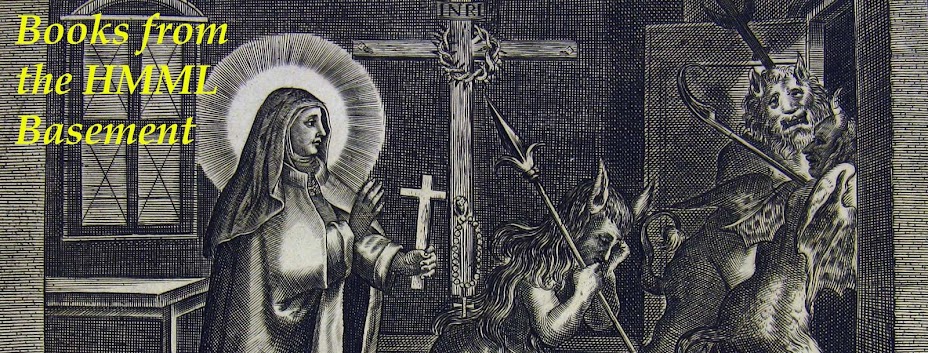Those who make books generally do so because they love sharing their books with others. This is certainly true for printers and publishers who have produced "Christmas books" over the years. These books are not necessarily books about Santa and reindeer, nor are they do they focus ghosts of Christmasses past, present or future. No, these Christmas books are special publications made at Christmastime to share with friends and clients of the publishing house. Thus, these books are usually printed in smaller numbers and most are set aside in advance as gifts, not as commercial products. As such, they often give us a small taste of what a publishers/printers/designers consider in their work to be the best, most playful, or spiritually meaningful.
 |
| Some of the numerous Christmas books designed by Frank Kacmarcik, Obl.S.B., and published by Al Muellerleile at North Central Publishing. |
The Hill Museum & Manuscript Library has a large collection of such Christmas books from a Twin Cities (Minnesota) printing house: North Central Publishing, led by Al Muellerleile (1908-1985). Mr. Muellerleile was long a friend of Saint John's University, and a number of the books in our Special Collections were donated by him. Beyond that, however, Al Muellerleile was a good friend of Frank Kacmarcik (1920-2004), a book artist, liturgical artist, graphic designer, and consultant for liturgical spaces. Together, they produced annual Christmas books from the late 1940's into the early 1980's. Below are a few examples of the books they produced.
Click on any image below to see it enlarged.
 |
| The Birth of the Lord Jesus Christ (based on Matthew and Luke), with designs by Frank Kacmarcik. |
 |
| Title page of A Nativity Sequence (1954). |
 |
| The Magi bring their gifts to the Christ Child in Frank Kacmarcik's rendition. |
 |
| Seasons of Hope - an appropriate title at Christmastime. |
 |
| The colophon of one of the Christmas books, with the NCP monogram (North Central Publishing), listing the artists involved in the project, and specifying the number of copies made and the specific number of this copy. |
The North Central Christmas books included more than just retellings of the Nativity. There were also stories or poems by Vincent Arthur Yzermans, Eugene McCarthy, Pope John XXIII, Pope John Paul II, Saint Ephrem, and Al Muellerleile, himself!
 |
| A title by Pope John Paul II from early in his papacy. |
 |
| Cover design by Frank Kacmarcik. |
In general, North Central Publishing produced 1200 copies of these books, so it is no surprise that not all of them were promptly given away. When Frank Kacmarcik donated his collections of art, rare books and reference books (the "
Arca Artium Collection") to Saint John's University, he included many copies of each of these books. To learn more about his art collection, look for "Arca Artium" in
Vivarium, and for his book collections, look for "Arca Artium" in
MnPALS.
 |
| Life of Saint Benedict, based on a 16th-century pictorial biography. |
 |
| Pages from the life of Benedict, showing his early conflicts with monastic communities at Subiaco. |
HMML takes care of a great many other Christmas books in the Saint John's Special Collections, but no other series of special Christmas books is so well represented as the North Central books. These, and all the books in Saint John's Special Collections, are available for viewing on request. Feel free to contact
HMML or the
author of this article if you wish to learn more about the Library's collections.
May this Christmas season bring peace and joy to all!































